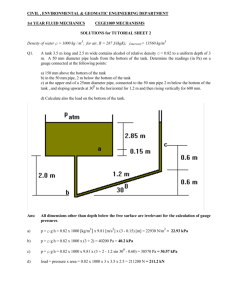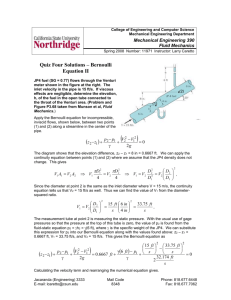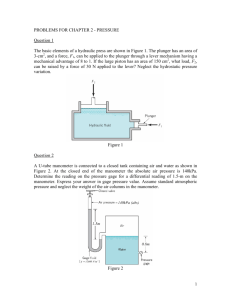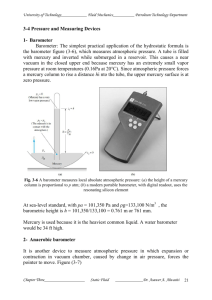FLUID STATICS. MANOMETERS. Ex. 1. A tank is constructed of a
advertisement
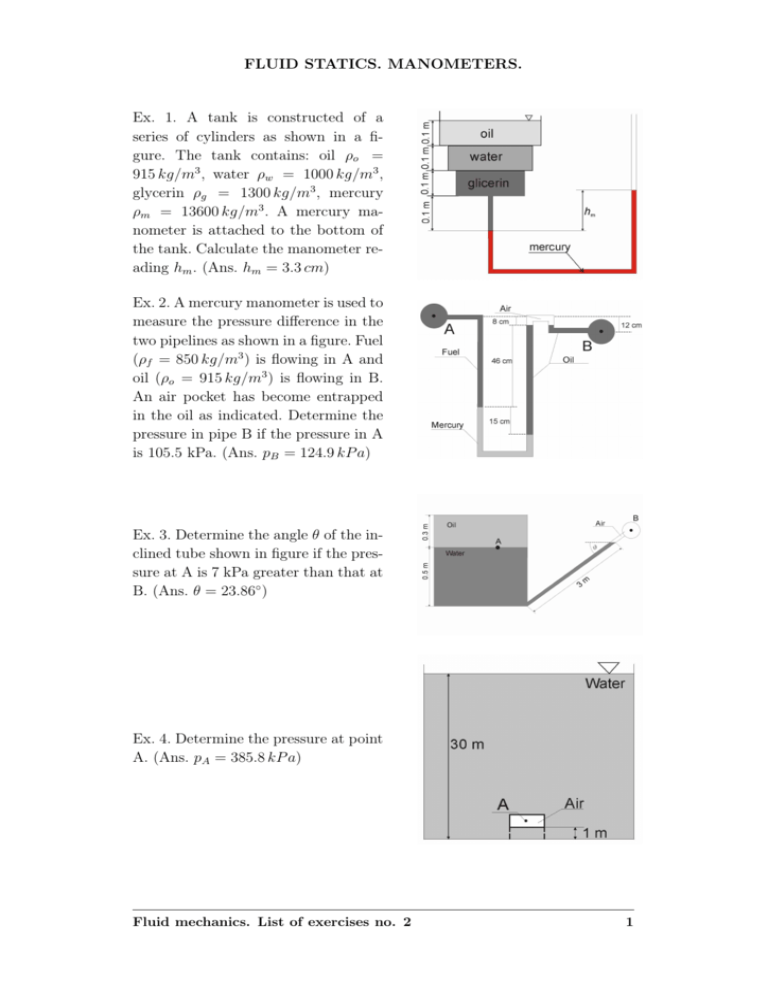
FLUID STATICS. MANOMETERS. Ex. 1. A tank is constructed of a series of cylinders as shown in a figure. The tank contains: oil ρo = 915 kg/m3 , water ρw = 1000 kg/m3 , glycerin ρg = 1300 kg/m3 , mercury ρm = 13600 kg/m3 . A mercury manometer is attached to the bottom of the tank. Calculate the manometer reading hm . (Ans. hm = 3.3 cm) Ex. 2. A mercury manometer is used to measure the pressure difference in the two pipelines as shown in a figure. Fuel (ρf = 850 kg/m3 ) is flowing in A and oil (ρo = 915 kg/m3 ) is flowing in B. An air pocket has become entrapped in the oil as indicated. Determine the pressure in pipe B if the pressure in A is 105.5 kPa. (Ans. pB = 124.9 kP a) Ex. 3. Determine the angle θ of the inclined tube shown in figure if the pressure at A is 7 kPa greater than that at B. (Ans. θ = 23.86◦ ) Ex. 4. Determine the pressure at point A. (Ans. pA = 385.8 kP a) Fluid mechanics. List of exercises no. 2 1 Ex. 5. A weight lies on a piston with a radius r2 = 1.0 m. Determine the force F1 applied to the piston with radius r1 = 20 cm if the hydraulic jack is in a balance. The jack is filled by an oil with ρo = 850 kg/m3 . A mass of weight is mw = 1000 kg. Neglect the mass of the pistons. (Ans. F1 = 392.4 N ) Ex. 6. An inverted U-tube manometer is used to measure the difference of water pressure between two points in a pipe. Find the difference of pressure between point B and A if the density of water is ρ = 103 kg/m3 , h1 = 60 cm, h = 45 cm, h2 = 180 cm. (Ans. pBA = 16.2 kP a) Ex. 7. In figure, fluid A is water and fluid B is mercury. What will be the difference in level h1 if the pressure at X is 140 kN/m2 and h2 = 1.5 m. (Ans. h1 = 40 cm) Ex. 8. Calculate a manometer reading h if density of oil ρo = 800 kg/m3 , density of water ρw = 1000 kg/m3 and density of mercury ρm = 13600 kg/m3 , h1 = 8m h2 = 4 m, h3 = 2 m. (Ans. h = 0.45 m) Fluid mechanics. List of exercises no. 2 2 Ex. 9. Calculate a formula for manometer reading h2 for a situation shows at figure. As a known values we have: h3 , h, ρ1 , ρ2 , ρw . (Ans. h2 = (hρw − h3 ρ1 )/ρ2 ) Ex. 10. A mercury manometer is connected to open tank of fuel. Calculate a change of manometer reading h if a level of fuel increases about ∆ H. (Ans. ∆h = ∆H ρf /(2ρm − ρf )) Ex. 11. In well-type manometer (with constant zero level) there is neglected a change of fluid level in w big vessel (diameter D). Calculate a ratio d/D for which an error connected with a change of fluid level ∆H is less than 1%. (Ans. d/D 6 0.1) Ex. 12. A mercury manometer connects two oil pipelines. Calculate a pressure difference between points A and B if H = 2 m, ∆ h = 0.2 m, ρo = 800 kg/m3 , ρm = 13600 kg/m3 . (Ans. pAB = 9.418 kP a) Fluid mechanics. List of exercises no. 2 3

